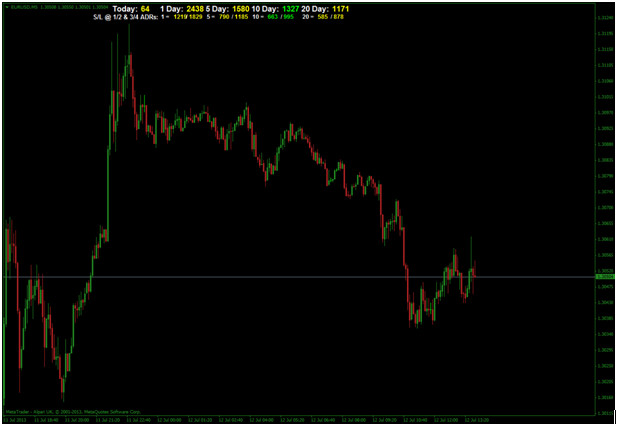Average Daily Range Tool – Any Steam Left?
Full Review of the Average Daily Range Tool for Binary Options
It’s time to bring you another tool review. Whenever I present you a new custom indicator or tool, I try to find something that is actually useful to the trader, not just something that looks cool on a chart. Today’s indicator is by no means a good looking one; just some numbers on a chart. But those numbers help us see when price has traveled a long enough distance for us to stop trading or even trade counter trend. So let’s get to work. (Find download at the bottom of page)
What is the Average Daily Range and how to use it?
An asset has an average daily distance it travels and if it usually moves around 100 pips, you will rarely see extremes like 20 or 400 pips movement in a day. In other words, if the daily range is 100, price will usually move each day somewhere around that range. Here’s how the indicator looks like on a chart:

Not visually impressive, I told you, but it is of great help for traders because with the use of this indicator they can measure in a way how much steam price has got left. For example, if I know the 10 day range of a currency pair is 132 pips (I’m using the number from the picture above just for exemplification purposes) and when I want to open my trade, price already moved 120-130 pips (the direction is not important), I will probably stay put and look for another asset to trade because it means I missed the trend for that day and price is likely to stall or even reverse. This is not a fixed rule and instead it must be considered just a heads-up, an early indication that price has reached the average distance it moves.
The “Average Daily Range” indicator shows you the average for 1 day, five days, ten days and twenty days. The shorter the period the average is calculated, the more it can fluctuate. For example, if you will use the indicator, you will see the 1 Day number changes a lot more than the 20 Day. I like to use the medium average range which is 5 days or 10 days and I usually don’t trade on a pair that comes close to its 5 or 10 day range.
Why does the “Average Daily Range” Suck?
Just like any tool, it can backfire on you because the average range can be often surpassed or not reached. A strong fundamental event can overthrow any daily range; just recently we saw EUR/USD move for about 450 pips in a single day… a lot more than its 5 or 10 day average distance. On the other hand, I saw days when price moved just 40 pips the entire day, way lower than the normal range. This just shows that price is not confined by any indicator and it will not move according to that.
Why doesn’t the “Average Daily Range” Suck?
Although price will not move a certain way just because an indicator tells it to do so, technical analysis is based on repetition and on the idea that history repeats itself. That’s how support and resistance works, chart patterns, etc. And that’s what makes the average daily range important. If an asset has a certain behavior, it will usually move according to that behavior and this includes the distance traveled each day. Unless something important happens, assets will stay inside their normal range.
Wrapping it up – See the Trend gets Exhausted
Traders have to be aware of many things if they want to use trading to pay for their bills. It is sometimes overwhelming assimilate so much information and to process it before every trade, but it is the price to pay. This indicator can be used to see signs of exhaustion in a trend and an informed trader is a better trader: if the trend is exhausted, maybe it’s time for some IN Boundary Options or even some counter trend trading. Either way, it can’t hurt to know how much distance price traveled during the current day and compare it with a 5, 10 or 20 day average range.
Downloads and Further Reading:
- Download Average Daily Range Indicator for Binary Options
- Continue on Forum: Average Daily Range Indicator Discussion